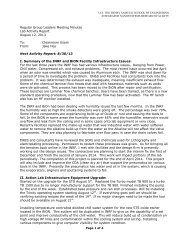Download Lab Safety Manual - Integrated Nanosystems Research ...
Download Lab Safety Manual - Integrated Nanosystems Research ...
Download Lab Safety Manual - Integrated Nanosystems Research ...
You also want an ePaper? Increase the reach of your titles
YUMPU automatically turns print PDFs into web optimized ePapers that Google loves.
#7 Emergency Procedures:<br />
Describe immediate medical treatment required in case of personnel exposure.<br />
-Complete online incident report form at www.ehs.uci.edu<br />
First Aid:<br />
Remove contaminated clothing and shoes while flushing with water. Get medical attention<br />
immediately.<br />
Eyes: wash eyes immediately with large amounts of water, occasionally lifting upper and<br />
lower lids, at least 15 minutes.<br />
Skin: wash affected area with soap or mild detergent and large amounts of water for five<br />
minutes. Rinse scalp and areas underneath skin folds thoroughly.<br />
Apply calcium gluconate gel by rubbing it gently into the affected area.<br />
Inhalation: remove to fresh air immediately.<br />
Seek medical attention even if you don’t feel the pain when exposed to any HF.<br />
Before beginning work involving HF an exposure kit must be available and located in the<br />
laboratory area. The exposure kit must contain the following items:<br />
1. Container of calcium gluconate gel. This gel must be inspected<br />
before each use of HF or at least monthly to ensure the gel has not<br />
been removed or has not reached the expiration date. If a tube of the<br />
gel has been opened, a new container must be purchased and the old<br />
container discarded. No work with HF can be done with an expired<br />
tube of calcium gluconate gel.<br />
2. Stanolv Neoprene (11mil) gloves.<br />
3. One heavy-duty polyethylene bag to be used for items contaminated<br />
by HF.<br />
4. One HF Contaminated Waste <strong>Lab</strong>el.<br />
5. Copy of these procedures and MSDS to take to the emergency room.<br />
#8 Identify waste stream and disposition of waste, and unused stock of chemicals<br />
(Identify if waste is biohazardous, pathological waste, or hazardous waste,<br />
etc.) Additional guidelines regarding hazardous waste and pathological<br />
waste can be found at: http://www.ehs.uci.edu/programs/enviro/<br />
• Surplus chemicals will be disposed of as hazardous chemical waste.<br />
• Obtain waste containers from EH&S.<br />
• Sharps will be disposed of in “Sharps” container.<br />
• At Irvine locations, utilize the on-line system for requests by requesting a<br />
“Chemical Waste” Pickup via the Internet:<br />
Visit www.ehs.uci.edu/programs/enviro/<br />
91



